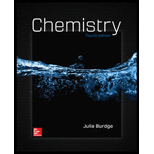
Concept explainers
Carry out the following conversions: (a)
Interpretation:
The given conversions are to be carried out by dimensional analysis.
Concept introduction:
Dimensional analysis is a way to convert the units of measurement. In order to convert one unit to another, one needs to know the relationship between those units. These relationships are called conversion factors. Dimensional analysis is used to set up and solve a unit conversion problem using conversion factors.
Conversion factor is a fraction obtained from a relationship between the units. It is written as a ratio, and can be inverted to give two conversion factors for every relationship.
Answer to Problem 57QP
Solution:
a)
b)
c)
d)
Explanation of Solution
a)
Convert the quantity
The conversion factors for the relationship
The conversion factors for the relationship
Now, set up the unit conversion problem using the appropriate conversion factors.
The units in the conversion factor must cancel to give the correct unit for the answer. The answer is rounded off to
Hence,
b)
Convert the quantity
The conversion factors for the relationship
Now, set up the unit conversion problem using the appropriate conversion factor.
The units in the conversion factor must cancel to give the correct unit for the answer.
Hence,
c)
Convert the quantity
The conversion factors for the relationship
Now, set up the unit conversion problem using the appropriate conversion factor.
The units in the conversion factor must cancel to give the correct unit for the answer. The answer is rounded off to
Hence,
d)
Convert the quantity
The conversion factors for the relationship
The conversion factors for the relationship
Now, set up the unit conversion problem using the appropriate conversion factors.
The units in the conversion factor must cancel to give the correct unit for the answer.
Hence,
Want to see more full solutions like this?
Chapter 1 Solutions
Chemistry
- help draw the moleculearrow_forwardHow to draw this claisen condensation reaction mechanisms/arrow_forwardWrite all of Me Possible Products For each Of the Following reactions. In each case identity all pains of enantiomers, all digsterzoners and all Meso compounds 9. 11-60 11-0-11 V-G Η Η H ~ C-11 +HB+ - 1 H b. पन्ना 171-0-11 H-C-H Н C-C=c-call +HBr Perendez ==arrow_forward
- How can i draw the mechanisms for this molecule?arrow_forwarda. Discuss and explain he difference IN Stability between the Chai and Boat Гольцу от судомехане b. For the Following Molecule draw both possible Clain conformations and explain which one is more stable and for what Reason. H. CH₂ CH₂ H "Harrow_forwarddraw out these molecules pleasearrow_forward
 ChemistryChemistryISBN:9781305957404Author:Steven S. Zumdahl, Susan A. Zumdahl, Donald J. DeCostePublisher:Cengage Learning
ChemistryChemistryISBN:9781305957404Author:Steven S. Zumdahl, Susan A. Zumdahl, Donald J. DeCostePublisher:Cengage Learning ChemistryChemistryISBN:9781259911156Author:Raymond Chang Dr., Jason Overby ProfessorPublisher:McGraw-Hill Education
ChemistryChemistryISBN:9781259911156Author:Raymond Chang Dr., Jason Overby ProfessorPublisher:McGraw-Hill Education Principles of Instrumental AnalysisChemistryISBN:9781305577213Author:Douglas A. Skoog, F. James Holler, Stanley R. CrouchPublisher:Cengage Learning
Principles of Instrumental AnalysisChemistryISBN:9781305577213Author:Douglas A. Skoog, F. James Holler, Stanley R. CrouchPublisher:Cengage Learning Organic ChemistryChemistryISBN:9780078021558Author:Janice Gorzynski Smith Dr.Publisher:McGraw-Hill Education
Organic ChemistryChemistryISBN:9780078021558Author:Janice Gorzynski Smith Dr.Publisher:McGraw-Hill Education Chemistry: Principles and ReactionsChemistryISBN:9781305079373Author:William L. Masterton, Cecile N. HurleyPublisher:Cengage Learning
Chemistry: Principles and ReactionsChemistryISBN:9781305079373Author:William L. Masterton, Cecile N. HurleyPublisher:Cengage Learning Elementary Principles of Chemical Processes, Bind...ChemistryISBN:9781118431221Author:Richard M. Felder, Ronald W. Rousseau, Lisa G. BullardPublisher:WILEY
Elementary Principles of Chemical Processes, Bind...ChemistryISBN:9781118431221Author:Richard M. Felder, Ronald W. Rousseau, Lisa G. BullardPublisher:WILEY





